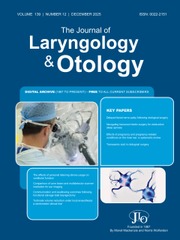We are grateful to Professor Des Nunez, Professor Pat Bradley, Liam Flood and Catherine Hyland for their work in categorising, analysing and scoring all 2024 papers that we published to identify prize winners. This is an onerous task. We are particularly grateful to Mr Iain Swan, who has just retired as Assistant Editor and has worked hard as a previous best paper judge. Iain has spent many years as a stalwart supporter of The Journal of Laryngology & Otology in several roles, including as Trustee. We shall sorely miss his enthusiasm for the integrity of our articles, help for our authors and dedication to our work.
Two papers were selected as joint winners, both from the ‘main article’ category, and we congratulate the winners, who receive a prize and have an opportunity to present a video outlining their work at our annual meeting in London in March 2025.
Saad Elzayat and colleagues from Kafrelsheikh University, Egypt authored a paper looking at different modes of corticosteroid administration in patients with chronic rhinosinusitis with nasal polyps entitled ‘The role of budesonide intrapolyp injection in the management of type 2 chronic rhinosinusitis with nasal polyps: a randomised clinical trial’.Reference Elzayat, Elgendy, Lasheen, El-Deeb, Aouf and Gehad1 Systemic steroid prescribing has been the topic of a recent The Journal article based on a survey in Scotland, and heterogeneity of practice was demonstrated.Reference Misirovs, Hoey, Lipworth and Green2 The investigators compared three groups, one group with 3 days of oral systemic steroids then tapered for two weeks, one group with five weeks of weekly intralesional injection of budesonide and one group using a saline douche incorporating budesonide respules twice daily for a month. The principal advantage of the injection group is that there is little or no risk of systemic effects of corticosteroid, which limits use of the oral and douche method, and no serious adverse effects have been described. All groups improved their polyp score and Sino-Nasal Outcome Test-22 score, but the oral and injection groups performed better than the douche group. From a UK perspective, the main obstacle to incorporating this injection option is the need for weekly visits to an ENT department, which would put a great strain on a publicly funded service that is currently struggling with capacity and demand.
The second prize-winning paper was produced by Ericka Erickson and colleagues from Ohio State University College of Medicine in Columbus, USA, entitled ‘Recurrent respiratory papillomatosis disease course in immunosuppressed populations’.Reference Erickson, Freeman, Sun, Koch, Allen and Sethia3 They investigated adults with recurrent respiratory papillomatosis. This fascinating condition has been the topic of many papers in The Journal in recent years, with most involving children, but some involving adults.Reference Balai, Dronkers, Yaghchi, Gujral, Sandhu and Iacovidou4, Reference Chandrasekar, Bell and Kinshuck5 The prize-winning paper produced a rarity: an ‘interesting’ paper that is ‘negative’ in its results. The point of the paper is that recurrent respiratory papillomatosis is a relentless condition, often needing frequent laryngological interventions, which is assumed to be due to an inability of the patient’s immune system to control the effects of the human papilloma virus, usually types 6 and 11. Were matters to be that simple, it would be reasonable to assume that any patient with poor immune function (such as known immunosuppression from whatever cause) or metabolic conditions that are known to influence immunity adversely (such as diabetes mellitus) should have less aggressive disease and have less of a burden of interventions. The study population here were assembled retrospectively over a 5-year period and included 66 immunocompetent patients, 13 immunosuppressed patients and 18 diabetic patients, making a total of 97 adults. Surprisingly, there was no evidence that either immunosuppression or diabetes mellitus led to significant differences in the need for surgical intervention or voice handicap index. Despite the methodological limitations of this study, it is surprising that the immunosuppressed groups showed no difference, so perhaps we still have much to learn about this enigmatic condition.

